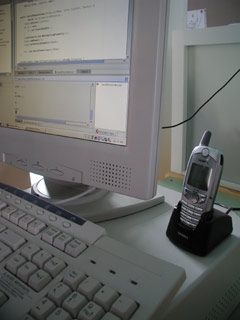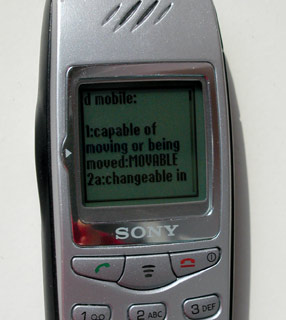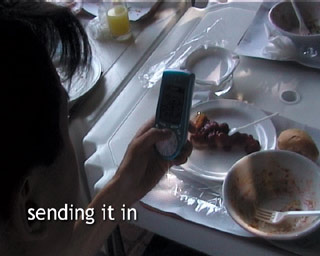-
In this prototype, volunteers with cell phones were given access to a special phone number for nine days. During this time, they could send SMS requests to the number for automated dictionary, thesaurus, Italian-English or English-Italian translation lookups. The receiving cell phone sent the request via a cradle cable to a computer running a custom-written Java server. The program stored the request in a log file, parsed it, scraped responses from appropriate websites, formatted the responses, and sent the response back to the phone for immediate delivery. Response time was typically within 10 seconds.
Scraping is a method of gathering information from Web pages, where the server requests the page from the Web, stores it in memory, and obeys programming to pick out only the relevant parts for use. This method is not permissible for commercial applications, and was only chosen to expedite the development process. In the ideal implementation, the service would establish relationships with the content providers.
Users could also use the same system to send open-ended questions to the service. In response to such questions, the system emailed the question to the author, who would research the answer and manually send an SMS response. Response times varied but were usually provided within an hour.
Users were surveyed at the end of the week, in which they could review their logged queries, provide the location and circumstances of each query, and answer questions about the experience.
|
|
||||
|
Streaming Video
View a 3 MB Quicktime streaming video.View a 7 MB Quicktime streaming video.
Experience Prototype Results
-
Some small usability problems were discovered in the prototype. For example, the first iteration of the service used a dash as the command delimiter, e.g., "d-mobile" was the correct command to request a dictionary lookup of the word "mobile." It was discovered that for most of the test subject's cell phone interfaces, dashes are difficult characters to find and enter, accessible only through submenu systems that made the requests unnecessarily complex. In subsequent tests, the use of a delimiter was omitted, such that the command "d smile" would suffice. Though this required slightly more complex programming to be able to handle multiple-word requests, the benefits in usability warranted the change.
The responses indicated interest in such a service. Eight of nine volunteers said in post interviews that they would agree to have a small monthly fee added to their phone bill for the continued use of the service. The ninth volunteer became frustrated with the command syntax and when she finally mastered it, discovered that the word she requested, "diegetic," was not in the referenced dictionary. In her response she clarified that given a better dictionary, she would be interested in such a service. All would opt for a charge per request rather than a monthly service fee, at an average acceptable price point of 14 cents/request.
Volunteers reported a wide variety of circumstances that prompted their requests. Duplicate circumstances included native English speakers trying to explain a word with an intricate definition to non-native speakers, settling debates in conversation, and cooking using foreign-language and metric instructions. Significantly, three reported that they felt more empowered and encouraged to ask questions about things around them.
The surveys revealed an unexpected aspect of the experience. Users reported that the time delays involved with the Cavalry service were not always important. While a few users needed their information immediately, most felt it was enough to be able to "capture" the question at the moment they thought of it. For example, one user lost his cell phone for two days. When he found it and read the response to an earlier query, he was immediately reminded of the moment he asked the question and felt the time delay reinforced his interest in the topic.
| NEXT> Body Learning |


